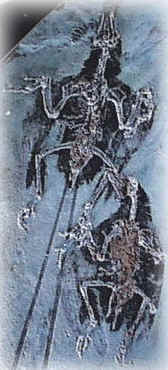
| Palaeos |  |
Aves |
| Vertebrates | Confuciusornithidae |
| Page Back | Unit Home | Unit Dendrogram | Unit References | Taxon Index | Page Next |
| Unit Back | Vertebrates Home | Vertebrate Dendrograms | Vertebrate References | Glossary | Unit Next |
|
Abbreviated Dendrogram
COELUROSAURIA | AVES |--Archaeornithes `--+--Confuciusornithidae `--Ornithothoraces |--Enantiornithes `--Ornithurae |--Hesperornithiformes `--Neornithes |--Paleognathae | |--Lithornithiformes | `--Ratites `--+--GALLOANSERAE `--GRUIMORPHA |
Contents
Index |
 Confuciusornithidae:
Confuciusornis, Changchengornis. Primitive birds with extraordinarily
long wing feathers and long caudal display plumage.
Confuciusornithidae:
Confuciusornis, Changchengornis. Primitive birds with extraordinarily
long wing feathers and long caudal display plumage.
Range: Late Jurassic to Early Cretaceous of China.
Phylogeny: Aves :: Ornithothoraces + *.
Characters: $ Toothless jaws; $ mandibular symphysis anteriorly forked; $ foramen on ascending process of maxilla within antorbital fenestra; pygostyle present?; wings short; $ very large deltopectoral crest on humerus; deltopectoral crest pierced by foramen; humerus straight; manus II flattened; $ manus II ungual nublike & much smaller than unguals on I and III; $ V-shaped posterior sternum; lateral sternal processes project posteriorly; tarsometatarsus not distally fused.
Note: interesting passage from Rayner2003:
Confuciusornithidae The two taxa in this family—Confuciusornis (Hou et al. 1995, 1996; Peters & Qiang 1999) and Changchengornis (Ji et al. 1999)—are characterized by unusual humerus morphology and a reduced tail skeleton with a pygostyle; they retain three independently movable digits with a semi-lunate carpal on the second digit, and have a sternum with a shallow keel and a strong furcula. They do not have an alula, and the triosseal canal is absent (Hou, this volume) indicating they had not evolved an elevating supracoracoideus. There is no aerodynamic tail; there was a very short aerodynamically non-functional tail fan, but in Changchengornis and in some individuals of Confuciusornis there are extended ribbon-like streamer feathers which are unlikely to have aerodynamic function but were probably used display or sexual selection; in Confuciusornis this represent the earliest example of sexual dimorphism in birds. The humerus has an enlarged delto-pectoral crest extending for approximately half the length of the humerus, and with a broad circular outline. I propose that this correlates with the absence of a functional tail, alula and an elevating supracoracoideus; these last two structures may then be ornithothoracine characters, as argued above. An important feature of ornithothoracines, which is apparently not shared with confuciusornithids, is the coevolution of the wing and tail into the flight locomotor system (Gatesy & Dial 1996a). This lineage evolved to use two independent aerodynamic surfaces, the wings and the tail, to control stability in flight, moving the wing by combinations of pronation and supination, depression and elevation by supracoracoideus and pectoralis, flexing and rotating the wrist, and controlling airflow over the wing by an alula. This lineage led to modern birds (figure 1), which share this suite of control strategies. By contrast, confuciusornithids appear to have developed along different lines, with the relatively long, high aspect ratio wings being responsible for all propulsion and control, and the tail becoming mechanically redundant. The enlarged delto-pectoral crest of the humerus means that the locations of insertion of fibres from the pectoralis (and possibly the deltoid or a supracoracoideus homologue) are spread over a broader area, thereby giving greater control over the position and posture of the wing. The size of the crest indicates more extensive pronation and supination movements. This would be correlated with the short coracoid in these birds. Although the alula is absent, the third finger probably had the same function in controlling separation of the upper surface airflow (Peters & Qiang 1999). Tailless birds are highly agile and manoeuvrable (compare modern swifts, Apodidae), but aerodynamically are statically unstable. If confuciusornithids were the agile fliers that they appear to be, then like swifts they were probably aerial insectivores; at this relatively early stage in the avian radiation the capacity to evolve advanced neural control and sensory systems essential for this unstable form of flight was already present. Arboreality in Confuciusornithidae is unlikely (Peters & Qiang 1999; Chiappe et al. 1999), and is not necessarily consistent with aerial insectivory or their long, high-aspect-ratio wings.
Links: Digimorph - Confuciusornis sp. (Chinese fossil avian); Rayner2003; Los primeros dinosaurios voladores; Image: Confuciusornithidae [The Dinosauricon] (excellent images by Martin Chavez); QB8 - Quando i dinosauri spiccarono il volo (source of image); 本室發現孔子鳥化石兩周年紀念 (weird article in English, also Chinese; but the graphics are very much worth the visit).
References: Chiappe et al. (1999). ATW030710.
| Page Back | Unit Home | Page Top | Page Next |
checked ATW050717